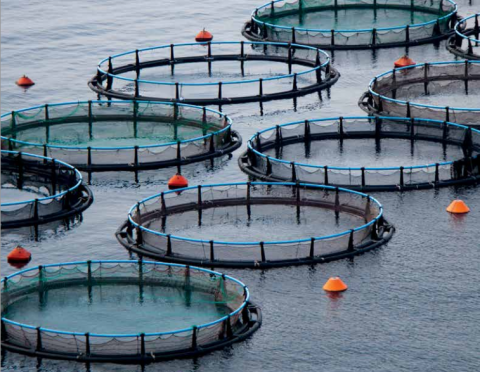You are here
Does Fish Farming Make Sense?

CWF takes position on the aquaculture debate: It´s time to stop
The aquaculture industry has been active in Canada since the 1980s. Several species of fish
and shellfish are now being raised commercially for consumption across the country.
Atlantic salmon, however, is the most important species, both in terms of production volumes and market values. The vast majority of these salmon are raised in the ocean waters of British Columbia (where it is not a native species), New Brunswick, Newfoundland and Labrador, and Nova Scotia.
Atlantic salmon are held and grown in cages that float in the ocean. Essentially, they’re open pens. These are usually located in areas where they are protected from storms but have good water flow—often in sheltered bays or near the mouths of rivers.
As with large-scale farming practices of any animal, salmon aquaculture—often called finfish aquaculture—requires maintaining animals in large densities, providing them with food and treating them with pharmaceuticals to maintain their health under these unnatural conditions. Unlike land-based farming, however, diseases, parasites, and food and pharmaceutical waste from finfish aquaculture operations freely flow from the open pens into the surrounding marine environment.
The various effects of aquaculture on the environment are a large concern, particularly the potential negative effects on nearby populations of wild salmon. Many populations of Atlantic salmon in New Brunswick and Nova Scotia, as well as several Pacific salmon species, are at risk of extinction according to the Committee on the Status of Endangered Wildlife in Canada, so the risks from open-pen salmon aquaculture are especially important.
To ensure we were evaluating aquaculture with substantiated knowledge, CWF conducted a detailed examination of the scientific literature on the environmental effects of salmon aquaculture. Some studies showed no significant environmental effect, while others did. The logical conclusion is that we can reject the assumption that open-pen finfish aquaculture has no effect on the environment; clearly, it does under some (even well-managed) conditions and in some locations.
If this is incorrect, then at best, we have failed to show adequately that finfish aquaculture does not harm wild salmon populations. But at worst, aquaculture may be destroying our wild salmon populations without our knowledge. In this state of ignorance, it is safe to conclude that we are not acting precautiously by allowing this industry to develop and to expand.
Thus, while recognizing the economic benefits of finfish aquaculture, the Canadian Wildlife Federation and its board of directors want an end to open-pen finfish aquaculture on both coasts of Canada in the next 10 years and, in the meantime, amoratorium on new finfish aquaculture operations. This position is in alignment with the conclusions of many other agencies concerned with the state of wildlife in Canada, including the Atlantic Salmon Federation, the Royal Society of Canada and the federally appointed Cohen Commission of Inquiry into the Decline of Sockeye Salmon in the Fraser River, the Canadian Wildlife Federation and its board of directors want an end to open-pen finfish aquaculture on both coasts of Canada in the next 10 years and, in the meantime, a moratorium on new finfish aquaculture operations.
http://cwf-fcf.org/assets/images/cw-bio-SO13/SepOct_2013_Bulletin.pdf
Copyright APES 2012 Website by Ionsign Online

